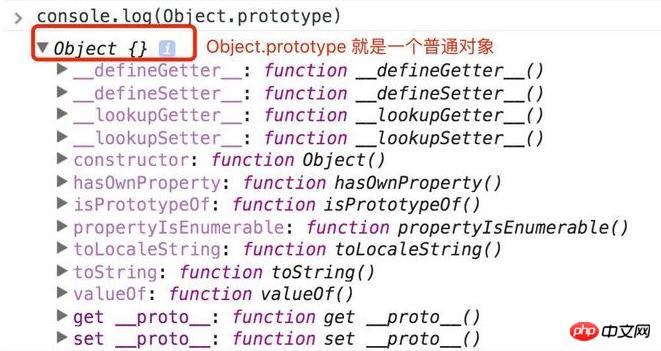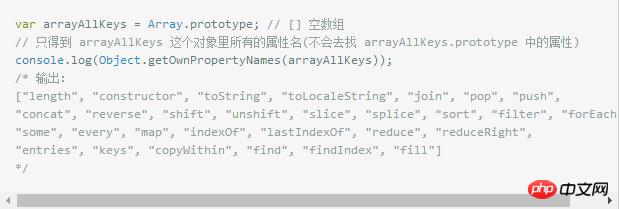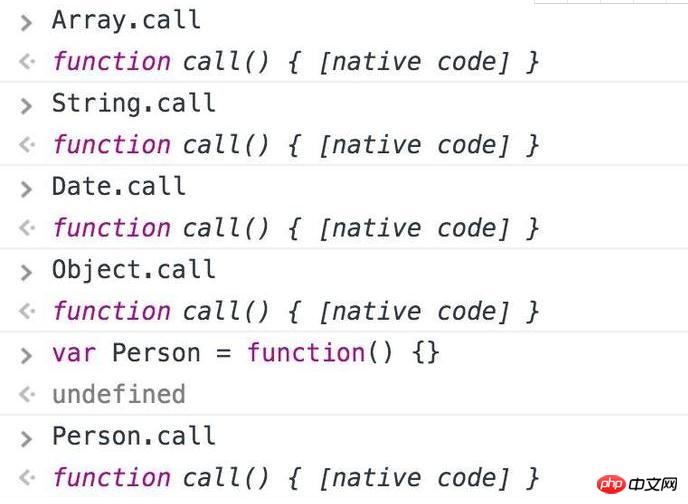詳解JS原型與原型鏈(三)
這次接著上篇跟小編一起來看看JS原型和原型鏈以及注意事項有哪些,下面就是實戰案例,一起來看一下。
#七.函數物件(複習一下前面的知識點)
所有函數物件的proto都指向Function.prototype,它是一個空函數(Empty function)
Number.__proto__ === Function.prototype // true Number.constructor == Function //true Boolean.__proto__ === Function.prototype // true Boolean.constructor == Function //true String.__proto__ === Function.prototype // true String.constructor == Function //true // 所有的构造器都来自于Function.prototype,甚至包括根构造器Object及Function自身 Object.__proto__ === Function.prototype // true Object.constructor == Function // true // 所有的构造器都来自于Function.prototype,甚至包括根构造器Object及Function自身 Function.__proto__ === Function.prototype // true Function.constructor == Function //true Array.__proto__ === Function.prototype // true Array.constructor == Function //true RegExp.__proto__ === Function.prototype // true RegExp.constructor == Function //true Error.__proto__ === Function.prototype // true Error.constructor == Function //true Date.__proto__ === Function.prototype // true Date.constructor == Function //true
JavaScript中有內建(build-in)建構器/物件共12個(ES5中新加了JSON),這裡列舉了可訪問的8個構造器。剩下如Global不能直接訪問,Arguments僅在函數呼叫時由JS引擎創建,Math,JSON是以物件形式存在的,無需new。它們的proto是Object.prototype。如下
Math.__proto__ === Object.prototype // true Math.construrctor == Object // true JSON.__proto__ === Object.prototype // true JSON.construrctor == Object //true
上面說的函數物件當然包括自訂的。如下
// 函数声明
function Person() {}
// 函数表达式
var Perosn = function() {}
console.log(Person.__proto__ === Function.prototype) // true
console.log(Man.__proto__ === Function.prototype) // true這說明什麼呢?
** 所有的建構子都來自於 Function.prototype,甚至包含根建構子Object及Function本身。所有構造者都繼承了·Function.prototype·的屬性及方法。如length、call、apply、bind**
(你應該明白第一句話,第二句話我們下一節繼續說,先挖個坑:))
Function.prototype也是唯一一個typeof XXX.prototype為function的prototype。其它的構造器的prototype都是一個物件(原因第三節已經解釋過了)。如下(又複習了一遍):
console.log(typeof Function.prototype) // function console.log(typeof Object.prototype) // object console.log(typeof Number.prototype) // object console.log(typeof Boolean.prototype) // object console.log(typeof String.prototype) // object console.log(typeof Array.prototype) // object console.log(typeof RegExp.prototype) // object console.log(typeof Error.prototype) // object console.log(typeof Date.prototype) // object console.log(typeof Object.prototype) // object
噢,上面還提到它是一個空的函數,console.log(Function.prototype) 下看看(留意,下一節會再說一下這個)
知道了所有建構器(含內建與自訂)的__proto__都是Function.prototype,那Function.prototype的__proto__是誰呢?
相信都聽過JavaScript中函數也是一等公民,那從哪能體現呢?如下
console.log(Function.prototype.__proto__ === Object.prototype) // true
這說明所有的建構器也都是一個普通 JS 對象,可以為建構器新增/刪除屬性等。同時它也繼承了Object.prototype上的所有方法:toString、valueOf、hasOwnProperty等。 (你也應該明白第一句話,第二句話我們下一節繼續說,不用挖坑了,還是剛才那個坑;))
最後Object.prototype的proto是誰?
Object.prototype.__proto__ === null // true
已經到頂了,為null。 (讀到現在,再回過頭看第五章,能明白嗎?)
八. Prototype
在ECMAScript 核心所定義的全部屬性中,最耐人尋味的就要數prototype 屬性了。對於 ECMAScript 中的引用類型而言,prototype 是保存著它們所有實例方法的真正所在。換句話說,諸如 toString()和 valuseOf() 等方法實際上都保存在 prototype 名下,只不過是透過各自物件的實例存取罷了。
——《JavaScript 高階程式設計》第三版P116
我們知道JS 內建了一些方法供我們使用,例如:
物件可以用constructor/toString()/valueOf () 等方法;
陣列可以用map()/filter()/reducer() 等方法;
數字可用用parseInt()/parseFloat()等方法;
Why ? ? ?
當我們建立一個函數時:
var Person = new Object()
Person 是Object 的實例,所以Person 繼承了Object 的原型物件Object.prototype上所有的方法:

Object.prototype
#Object 的每個實例都有上述的屬性和方法。
所以我可以用 Person.constructor 也可以用 Person.hasOwnProperty。
當我們建立一個陣列時:
var num = new Array()
num 是Array 的實例,所以num 繼承了Array 的原型物件Array.prototype上所有的方法:

Array.prototype
Are you f***ing kidding me? 這尼瑪怎麼是空數組? ? ?
我們可以用一個ES5 提供的新方法:Object.getOwnPropertyNames
取得所有(包含不可列舉的屬性)的屬性名稱不包含prototy 中的屬性,傳回一個陣列:

var arrayAllKeys = Array.prototype; // [] 空数组// 只得到 arrayAllKeys 这个对象里所有的属性名(不会去找 arrayAllKeys.prototype 中的属性)console.log(Object.getOwnPropertyNames(arrayAllKeys));
/* 输出:
["length", "constructor", "toString", "toLocaleString", "join", "pop", "push",
"concat", "reverse", "shift", "unshift", "slice", "splice", "sort", "filter", "forEach",
"some", "every", "map", "indexOf", "lastIndexOf", "reduce", "reduceRight",
"entries", "keys", "copyWithin", "find", "findIndex", "fill"]
*/
这样你就明白了随便声明一个数组,它为啥能用那么多方法了。
细心的你肯定发现了Object.getOwnPropertyNames(arrayAllKeys) 输出的数组里并没有 constructor/hasOwnPrototype等对象的方法(你肯定没发现)。
但是随便定义的数组也能用这些方法

var num = [1];console.log(num.hasOwnPrototype()) // false (输出布尔值而不是报错)
Why ???
因为Array.prototype 虽然没这些方法,但是它有原型对象(__proto__):
// 上面我们说了 Object.prototype 就是一个普通对象。 Array.prototype.__proto__ == Object.prototype
所以 Array.prototype 继承了对象的所有方法,当你用num.hasOwnPrototype()时,JS 会先查一下它的构造函数 (Array) 的原型对象 Array.prototype 有没有有hasOwnPrototype()方法,没查到的话继续查一下 Array.prototype 的原型对象 Array.prototype.__proto__有没有这个方法。
当我们创建一个函数时:
var f = new Function("x","return x*x;");
//当然你也可以这么创建 f = function(x){ return x*x }
console.log(f.arguments) // arguments 方法从哪里来的?
console.log(f.call(window)) // call 方法从哪里来的?
console.log(Function.prototype) // function() {} (一个空的函数)
console.log(Object.getOwnPropertyNames(Function.prototype));
/* 输出
["length", "name", "arguments", "caller", "constructor", "bind", "toString", "call", "apply"]
*/我们再复习第八小节这句话:
所有函数对象proto都指向 Function.prototype,它是一个空函数(Empty function)
嗯,我们验证了它就是空函数。不过不要忽略前半句。我们枚举出了它的所有的方法,所以所有的函数对象都能用,比如:

九. 复习一下
第八小节我们总结了:
所有函数对象的 __proto__ 都指向 Function.prototype,它是一个空函数(Empty function)
但是你可别忘了在第三小节我们总结的:
所有对象的 __proto__ 都指向其构造器的 prototype
我们下面再复习下这句话。
先看看 JS 内置构造器:
var obj = {name: 'jack'}
var arr = [1,2,3]
var reg = /hello/g
var date = new Date
var err = new Error('exception')
console.log(obj.__proto__ === Object.prototype) // true
console.log(arr.__proto__ === Array.prototype) // true
console.log(reg.__proto__ === RegExp.prototype) // true
console.log(date.__proto__ === Date.prototype) // true
console.log(err.__proto__ === Error.prototype) // true再看看自定义的构造器,这里定义了一个 Person:
function Person(name) {
this.name = name;
}
var p = new Person('jack')
console.log(p.__proto__ === Person.prototype) // truep 是 Person 的实例对象,p 的内部原型总是指向其构造器 Person 的原型对象 prototype。
每个对象都有一个 constructor 属性,可以获取它的构造器,因此以下打印结果也是恒等的:
function Person(name) {
this.name = name
}
var p = new Person('jack')
console.log(p.__proto__ === p.constructor.prototype) // true上面的Person没有给其原型添加属性或方法,这里给其原型添加一个getName方法:
function Person(name) {
this.name = name
}
// 修改原型
Person.prototype.getName = function() {}
var p = new Person('jack')
console.log(p.__proto__ === Person.prototype) // true
console.log(p.__proto__ === p.constructor.prototype) // true可以看到p.__proto__与Person.prototype,p.constructor.prototype都是恒等的,即都指向同一个对象。
如果换一种方式设置原型,结果就有些不同了:
function Person(name) {
this.name = name
}
// 重写原型Person.prototype = {
getName: function() {}
}
var p = new Person('jack')
console.log(p.__proto__ === Person.prototype) // true
console.log(p.__proto__ === p.constructor.prototype) // false这里直接重写了 Person.prototype(注意:上一个示例是修改原型)。输出结果可以看出p.__proto__仍然指向的是Person.prototype,而不是p.constructor.prototype。
这也很好理解,给Person.prototype赋值的是一个对象直接量{getName: function(){}},使用对象直接量方式定义的对象其构造器(constructor)指向的是根构造器Object,Object.prototype是一个空对象{},{}自然与{getName: function(){}}不等。如下:
var p = {}
console.log(Object.prototype) // 为一个空的对象{}
console.log(p.constructor === Object) // 对象直接量方式定义的对象其constructor为Objectconsole.log(p.constructor.prototype === Object.prototype) // 为true,
不解释(๑ˇ3ˇ๑)十. 原型链(再复习一下:)
下面这个例子你应该能明白了!
function Person(){
}var person1 = new Person();
console.log(person1.__proto__ === Person.prototype); // true
console.log(Person.prototype.__proto__ === Object.prototype) //true
console.log(Object.prototype.__proto__) //null
Person.__proto__ == Function.prototype; //true
console.log(Function.prototype)// function(){} (空函数)
var num = new Array()console.log(num.__proto__ == Array.prototype) // true
console.log( Array.prototype.__proto__ == Object.prototype) // true
console.log(Array.prototype) // [] (空数组)
console.log(Object.prototype.__proto__) //null
console.log(Array.__proto__ == Function.prototype)// true疑点解惑:
Object.__proto__ === Function.prototype // true
Object 是函数对象,是通过new Function()创建的,所以Object.__proto__指向Function.prototype。(参照第八小节:「所有函数对象的__proto__都指向Function.prototype」)
Function.__proto__ === Function.prototype // true
Function 也是对象函数,也是通过new Function()创建,所以Function.__proto__指向Function.prototype。
自己是由自己创建的,好像不符合逻辑,但仔细想想,现实世界也有些类似,你是怎么来的,你妈生的,你妈怎么来的,你姥姥生的,……类人猿进化来的,那类人猿从哪来,一直追溯下去……,就是无,(NULL生万物)
正如《道德经》里所说“无,名天地之始”。
Function.prototype.__proto__ === Object.prototype //true
其实这一点我也有点困惑,不过也可以试着解释一下。
Function.prototype是个函数对象,理论上他的__proto__应该指向 Function.prototype,就是他自己,自己指向自己,没有意义。
JS一直强调万物皆对象,函数对象也是对象,给他认个祖宗,指向Object.prototype。Object.prototype.__proto__ === null,保证原型链能够正常结束。
十一 总结
原型和原型链是JS实现继承的一种模型。
原型链的形成是真正是靠__proto__ 而非prototype
要深入理解这句话,我们再举个例子,看看前面你真的理解了吗?
var animal = function(){}; var dog = function(){};
animal.price = 2000;
dog.prototype = animal; var tidy = new dog(); console.log(dog.price) //undefined
console.log(tidy.price) // 2000这里解释一下:
var dog = function(){};
dog.prototype.price = 2000; var tidy = new dog(); console.log(tidy.price); // 2000
console.log(dog.price); //undefined
var dog = function(){}; var tidy = new dog();
tidy.price = 2000; console.log(dog.price); //undefined这个明白吧?想一想我们上面说过这句话:
实例(tidy)和 原型对象(dog.prototype)存在一个连接。不过,要明确的真正重要的一点就是,这个连接存在于实例(tidy)与构造函数的原型对象(dog.prototype)之间,而不是存在于实例(tidy)与构造函数(dog)之间。
聪明的你肯定想通了吧 :)
以上是詳解JS原型與原型鏈(三)的詳細內容。更多資訊請關注PHP中文網其他相關文章!

熱AI工具

Undresser.AI Undress
人工智慧驅動的應用程序,用於創建逼真的裸體照片

AI Clothes Remover
用於從照片中去除衣服的線上人工智慧工具。

Undress AI Tool
免費脫衣圖片

Clothoff.io
AI脫衣器

AI Hentai Generator
免費產生 AI 無盡。

熱門文章

熱工具

記事本++7.3.1
好用且免費的程式碼編輯器

SublimeText3漢化版
中文版,非常好用

禪工作室 13.0.1
強大的PHP整合開發環境

Dreamweaver CS6
視覺化網頁開發工具

SublimeText3 Mac版
神級程式碼編輯軟體(SublimeText3)

熱門話題
 Win11管理員權限取得詳解
Mar 08, 2024 pm 03:06 PM
Win11管理員權限取得詳解
Mar 08, 2024 pm 03:06 PM
Windows作業系統是全球最受歡迎的作業系統之一,其新版本Win11備受矚目。在Win11系統中,管理員權限的取得是一個重要的操作,管理員權限可以讓使用者對系統進行更多的操作和設定。本文將詳細介紹在Win11系統中如何取得管理員權限,以及如何有效地管理權限。在Win11系統中,管理員權限分為本機管理員和網域管理員兩種。本機管理員是指具有對本機電腦的完全管理權限
 Oracle SQL中的除法運算詳解
Mar 10, 2024 am 09:51 AM
Oracle SQL中的除法運算詳解
Mar 10, 2024 am 09:51 AM
OracleSQL中的除法運算詳解在OracleSQL中,除法運算是一種常見且重要的數學運算運算,用來計算兩個數相除的結果。除法在資料庫查詢中經常用到,因此了解OracleSQL中的除法運算及其用法是資料庫開發人員必備的技能之一。本文將詳細討論OracleSQL中除法運算的相關知識,並提供具體的程式碼範例供讀者參考。一、OracleSQL中的除法運算
 PHP模運算子的作用及用法詳解
Mar 19, 2024 pm 04:33 PM
PHP模運算子的作用及用法詳解
Mar 19, 2024 pm 04:33 PM
PHP中的模運算子(%)是用來取得兩個數值相除的餘數的。在本文中,我們將詳細討論模運算子的作用及用法,並提供具體的程式碼範例來幫助讀者更好地理解。 1.模運算子的作用在數學中,當我們將一個整數除以另一個整數時,就會得到一個商和一個餘數。例如,當我們將10除以3時,商數為3,餘數為1。模運算子就是用來取得這個餘數的。 2.模運算子的用法在PHP中,使用%符號來表示模
 linux系統呼叫system()函數詳解
Feb 22, 2024 pm 08:21 PM
linux系統呼叫system()函數詳解
Feb 22, 2024 pm 08:21 PM
Linux系統呼叫system()函數詳解系統呼叫是Linux作業系統中非常重要的一部分,它提供了一種與系統核心互動的方式。其中,system()函數是常用的系統呼叫函數之一。本文將詳細介紹system()函數的使用方法,並提供對應的程式碼範例。系統呼叫的基本概念系統呼叫是使用者程式與作業系統核心互動的一種方式。使用者程式透過呼叫系統呼叫函數來請求作業系統
 Linux的curl指令詳解
Feb 21, 2024 pm 10:33 PM
Linux的curl指令詳解
Feb 21, 2024 pm 10:33 PM
Linux的curl命令詳解摘要:curl是一種強大的命令列工具,用於與伺服器進行資料通訊。本文將介紹curl指令的基本用法,並提供實際的程式碼範例,幫助讀者更好地理解和應用該指令。一、curl是什麼? curl是命令列工具,用於發送和接收各種網路請求。它支援多種協議,如HTTP、FTP、TELNET等,並提供了豐富的功能,如檔案上傳、檔案下載、資料傳輸、代
 簡易JavaScript教學:取得HTTP狀態碼的方法
Jan 05, 2024 pm 06:08 PM
簡易JavaScript教學:取得HTTP狀態碼的方法
Jan 05, 2024 pm 06:08 PM
JavaScript教學:如何取得HTTP狀態碼,需要具體程式碼範例前言:在Web開發中,經常會涉及到與伺服器進行資料互動的場景。在與伺服器進行通訊時,我們經常需要取得傳回的HTTP狀態碼來判斷操作是否成功,並根據不同的狀態碼來進行對應的處理。本篇文章將教你如何使用JavaScript來取得HTTP狀態碼,並提供一些實用的程式碼範例。使用XMLHttpRequest
 詳細解析C語言學習路線
Feb 18, 2024 am 10:38 AM
詳細解析C語言學習路線
Feb 18, 2024 am 10:38 AM
C語言作為一門廣泛應用在軟體開發領域的程式語言,是許多程式設計師初學者的首選。學習C語言不僅可以幫助我們建立程式設計的基礎知識,還可以提升我們解決問題和思考的能力。本文將詳細介紹一條C語言學習的路線圖,幫助初學者更好地規劃自己的學習進度。 1.學習基本文法在開始學習C語言之前,我們首先需要先了解C語言的基本文法規則。這包括變數和資料類型、運算子、控制語句(如if語句、
 深入了解Promise.resolve()
Feb 18, 2024 pm 07:13 PM
深入了解Promise.resolve()
Feb 18, 2024 pm 07:13 PM
Promise.resolve()詳解,需要具體程式碼範例Promise是JavaScript中一種用來處理非同步操作的機制。在實際開發中,常常需要處理一些需要依序執行的非同步任務,而Promise.resolve()方法就是用來傳回一個已經Fulfilled狀態的Promise物件。 Promise.resolve()是Promise類別的靜態方法,它接受一個






